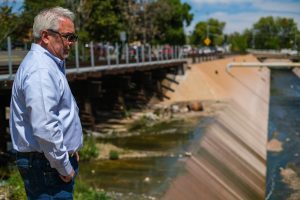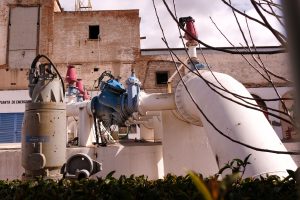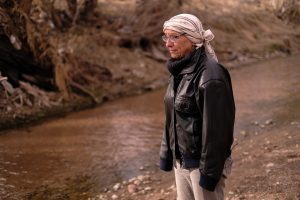- Slug: BC-CNS-Border Sewage. 2,360 words.
- 4 photos and captions below.
- Austin Westfall videos here and here.
- Brittany Watson video here.
EDS: An earlier version of this story misspelled the last name of Jayne Harkins, the commissioner of the U.S. section of the International Boundary and Water Commission, in the 37th graf. The story below has been corrected, but clients who used previous versions are asked to run the correction found here.
By CHLOE JONES
Cronkite News
NOGALES, Ariz. – People who live along the southern border all say the same thing: When it rains, it stinks.
The reason is a failing, aging network of pipes that run from Mexico to wastewater treatment plants in the U.S. When heavy rains fall, the pipes often break and spill raw sewage on both sides of the border, causing not only a putrid odor but public health and environmental concerns.
This infrastructure was sufficient when it was built about 70 years ago, but time and the escalating population on the Mexican side of the border has crippled it.
U.S. and Mexican officials say they need millions of dollars to fix the system, but that raises the key question: Who’s responsible for making repairs?
Over the past four months, a team of Cronkite News reporters addressed these concerns to understand the complexities of wastewater treatment along the border. Below are stories from the communities most affected by a system that has been in place since the 1940s.
The issues
Border cities in Mexico have much higher populations and growth rates than their U.S. counterparts, so the Mexican side produces much more wastewater and sewage to dispose of.
CILA, the Mexican section of the International Boundary and Water Commission, said “the high rate of growth derived from the migratory phenomenon exerts a strong pressure on its authorities to provide services and infrastructure that cover the needs of the growing population.”
Because Mexico’s elevation along the border is higher than the U.S. side, most water naturally runs north. Mexico isn’t necessarily “sending” its sewage to the U.S., it just flows there.
CILA said the main issue is insufficient funding for new construction, as well as maintenance and replacement of existing infrastructure.
As of Dec. 31, 2018, more than 30% of the $3.1 billion the binational North American Development Bank has contracted out since its establishment in 1994 has gone to water and wastewater projects, the most out of the 11 infrastructure issues NADB addresses.
Repairs for a pipe can cost $5 million, and building a new wastewater treatment plant can cost almost $20 million, so money runs out fast.
The bank, which was established under the North American Free Trade Agreement, works with municipalities, the IBWC, CILA and other agencies on both sides of the border to divvy up costs for these expensive but vital projects.
Renata Manning, director of grant financing for the bank, said it’s difficult to provide financing for preventative measures because NADB has scarce resources for grant funding, so money goes to places with the most critical conditions.
“It’s usually when there’s already a problem,” she said. “So we’re not able to necessarily focus the grant monies that we have available from EPA and the congressional appropriations to those projects that are vulnerable or at risk.”
One of the challenges the bank faces, she said, is the problems it’s meant to address need fast fixes that require fast money, and the NADB doesn’t necessarily do that. It makes sustainable investments, a lengthy process requiring planning, proper design and good construction.
Repairing aging wastewater treatment systems requires millions of dollars. That’s where the North American Development Bank, or NADB, comes in. Headquartered in San Antonio, Texas, it helps fund and technically assist infrastructure projects within 62 miles north of the U.S.-Mexico border and 186 miles south of it.
Part of NADB’s mission of supporting infrastructure development is to “help preserve, protect and enhance the environment of the border region in order to advance the well-being of the people of the United States and Mexico.”
It works closely with federal, state and local agencies on both sides of the border to do this. Spokesman Jesse Hereford said the bank’s priorities lie in the water, wastewater and solid-waste sectors.
Under the Clean Water Act, the U.S. government must ensure that foreign countries take meaningful action for the prevention, reduction and elimination of pollution in domestic and international waters.
According to the Environmental Protection Agency website, the act “establishes the basic structure for regulating discharges of pollutants into the waters of the United States and regulating quality standards for surface waters.”
Some officials of U.S. border cities say the IBWC violates the Clean Water Act because sewage continues to spill into their communities.
Tijuana and Imperial Beach
Imperial Beach, California, is home to the Tijuana River Estuary, one of the only coastal estuaries left in the U.S. It gives off a small surf-town vibe that reflects how laidback residents are. The diverse culture embraces its neighbor to the south, Tijuana, Mexico. Sewage is the main border concern on city officials’ minds.
The south end of the beach has been closed since Jan. 1, 2019. As of April 18, the main shoreline has been closed seven times because of raw sewage flowing into the estuary and the Pacific Ocean. That adds up to 39 days.
In December 2018, a pipeline collapsed and discharged about 68 gallons of raw, untreated sewage per second into the Tijuana River, which eventually spills into the Pacific at Imperial Beach. By the fourth day, CILA, the Mexican section of the International Boundary and Water Commission, reduced the flow to about 2 gallons per second.
“When there’s a lot of precipitation, the ocean recedes and the water mixes with the sewage water. That clogs the pumps because they are not designed to withstand that kind of pressure,” said Germán Lizola Marquez, director of the State Public Services Commission of Tijuana, known as CESPT.
Although sewage overflows are beyond Mexico’s control during rains, Lizola Marquez said CESPT, with the help of federal and binational agencies like CILA and the NADB, are looking to revamp Tijuana’s entire system, but it takes time and money.
“We need investment, money in order to do work, like everywhere else,” he said.
Pollutants are not constantly flowing in the river, he said: “I insist during normal season absolutely nothing happens. Everything is controlled.”
However, a draft of a study by U.S. Customs and Border Protection that took place January through July 2018 says otherwise. According to this study, there are 29 individual pollutants in the water, including chloroform, lead and E. coli. The study is expected to be finalized after another round of testing is concluded.
Councilwoman Paloma Aguirre said she has gotten sick from the contaminants in the water. In 2017, she was picking up trash during a beach cleanup ended up in urgent care 24 hours later.
“They told me I had viral pharyngitis and I did some research on that. And I learned it has a rapid onset and that it can be found in polluted conditions,” Aguirre said. She later learned some of her colleagues were bedridden for a week after the cleanup.
“That’s where we started. That’s when we realized that conditions didn’t need to be wet for us to start getting sick,” Aguirre said, referring to the uptick in sewage pollution caused by heavy rains.
Imperial Beach – along with Chula Vista, California, and the Port of San Diego – sued the International Boundary and Water Commission in 2018, alleging it violates the Clean Water Act.
“At one point, we had the acting commissioner of this agency sit down with local, regional, state and NGO stakeholders and tell us, ‘It’s not our responsibility, it’s yours,’” Aguirre said. “And that’s unacceptable.”
The only border crisis is sewage, she said.
“It’s the crisis related to the emergency of us receiving toxic sludge and sewage and trash into our waters and into our region.”
The IBWC twice has sought to have the lawsuit dismissed, and twice it has failed. Jayne Harkins, the commissioner for the U.S. section of the IBWC, said she could not comment on the lawsuit because it’s in litigation.
“We will continue to beat that drum and raise our voices until our administration and some of the other federal agencies take responsibility and help us out. I mean, it shouldn’t be entirely on our small little 28,000 resident community to completely fix,” Aguirre said.
Lifelong Imperial Beach resident William Bay learned to surf when he was 14, about the same time he learned how to take photographs.
“This kind of gives me the heartbeat of my life, you know? Imperial Beach will always be home, no matter where I live,” he said.
But Bay hasn’t surfed since 2017, after Hurricane Maria. He found out how dangerous the water can be, and gave up a favorite hobby to protect his health.
Nogales
Ambos Nogales – “ambos” meaning “both” in Spanish, referring to the twin cities on the two sides of the border – is home to the only binational sewage pipe and wastewater treatment plant. The pipe, known as the International Outfall Interceptor, transports sewage from both countries to be treated at the Nogales International Wastewater Treatment Plant in Rio Rico, which is managed by the IBWC.
When too much untreated sewage, usually containing heavy metals and industrial waste, flows into the pipe from Mexico, it overflows into the Nogales Wash and eventually reaches the Santa Cruz River, which provides drinking water to many southeastern Arizona communities, including Tubac and Carmen.
With the help of the NADB and CILA, Nogales, Mexico finished construction of the Los Alisos Wastewater Treatment Plant in 2012 to take pressure off the Rio Rico plant. Because of the topography of Nogales, Mexico, the plant uses five pumps to transport wastewater over a hill and to the plant. Four of these five pumps have been malfunctioning since mid-January 2019.
With the Los Alisos plant not working at full capacity, even more sewage is flowing into the International Outfall Interceptor. Right now, according to Lori Kuczmanski of the IBWC, nearly 180 gallons of raw sewage flows per minute into the wash during peak hours.
Jesús Pujol Irastorza, mayor of Nogales, Mexico, said the local government, with the help of CILA, purchased one pump motor, but it won’t be installed until mid-May. He doesn’t know whether that is a permanent fix. Each pump would cost about $100,000 to replace, he said.
Sherry Sass is the president of the Friends of the Santa Cruz River, a nonprofit volunteer group dedicated to protecting the Nogales Wash and Santa Cruz watershed.
“There’s such a focus on border security, but border environmental security? What happened to that? This seems like a very clear federal responsibility that they’ve been shirking,” Sass said. “Their rightful jurisdiction, which is really to protect communities that have no power to deal with what’s upstream in another country from impacting them.”
Deputy City Manager John Kissinger has worked for Nogales, Arizona, for 38 years, first as a police officer and now as deputy city manager. The relationship between the twin border cities of Nogales is “awesome,” he said, blaming the IBWC for the sewage issue.
“The (IBWC) are the ones who by treaty receive, convey and treat Mexican sewage, not us,” he said. “By law, we can’t. The only ones who can have an arrangement or agreement with a foreign country is the federal government.”
The IBWC charges Nogales, Arizona, for 23% of operation costs of the international treatment plant and wants to charge them for 23% of the repair costs for the International Outfall Interceptor. City officials object, noting that Arizona contributes just 8% of the sewage that’s treated.
In response, city officials have turned to Congress for relief. The city, with the help of Arizona Sen. Kyrsten Sinema, wrote the Nogales Fairness Act to address the issue; the bill has not yet been introduced.
Naco
In September 2018, Cochise County officials declared a state of emergency in Naco, the small border town just south of Bisbee. A ruptured sewage pipe had 200 to 300 gallons of raw sewage per minute flowing into the community every day. Although sewage crossing the border has been an issue for at least three decades, this was the first time sewage reached a residential area.
The flows have stopped for now, but a permanent solution is needed. One possibility is building a new pipeline.
Texas colonias
Colonias are small settlements near the U.S.-Mexico border that sprang up in the 1960s as a result of the Bracero Program, a guest worker program that supplied Mexican workers for agriculture jobs in the United States. Often, basic needs aren’t met.
The Department of Housing and Urban Development, or HUD, defines a colonia as an unincorporated area within 150 miles of the U.S.-Mexico border that lacks potable water, adequate sewage systems, decent, safe and sanitary housing, and existed as a colonia before the National Affordable Housing Act of 1990.
A 2015 report by the Rural Community Assistance Partnership submitted to the Department of Agriculture said 358,024 people live in the 1,884 colonias in Texas. Almost 500 of these colonias, home to 67,190 people, are not served by a public wastewater facility, or the existing public or private system is inadequate.
Texas has adopted a state-wide colonia classification system that details infrastructure quality by color.
Some colonias, with the help of local governments and the North American Development Bank, have centralized systems for sewage or wastewater. Manning, director of grant financing for the bank, said if a colonia does not have a centralized system, individual homes could have private systems, such as septic tanks. But septic tanks are less effective in densely populated areas, and in some areas, she said, shallow groundwater or poor soil conditions prevent their use.
Nuevo Laredo
The issue in the Mexican cities of Tijuana, Nogales and Naco is water crossing the border, but in Nuevo Laredo, Mexico, the issue is that water flows into the boundary itself – the Rio Grande.
The river is a water source for communities on both sides of the border. According to the IBWC, it contributes to 50% of the drinking water in El Paso County, Texas.
Manning, with the NADB, said after CILA identified 18 discharges in a collection system that feeds raw sewage into the Rio Grand, it applied to the bank for help in December 2017. The collection system is more than 40 years old and, according to a project summary from the bank, “has exceeded its useful life.”
Temis Alvarez, the east-region program manager for NADB, said bank officials reached an agreement with Nueva Laredo to address six direct wastewater discharges into Coyote Creek, a tributary of the Rio Grande. The bank is conducting studies addressing preliminary engineering and the preliminary final design for the infrastructure.
^_=



